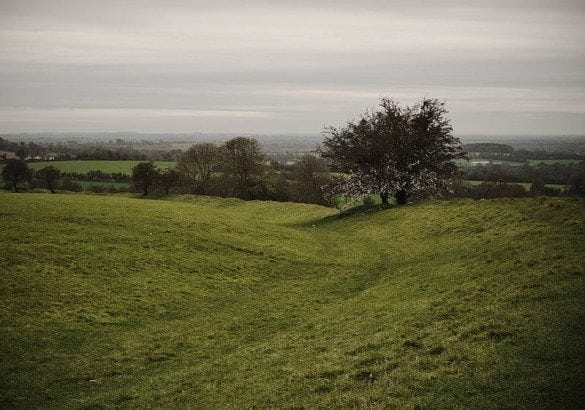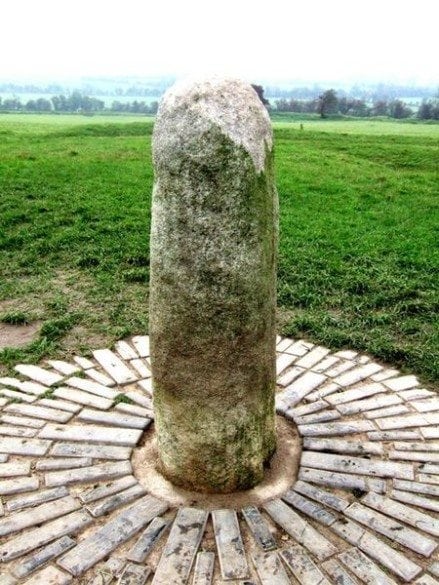
The Hill of Tara is one of the most important archaeological and mythical sites in all of Ireland. Its name regularly crops up in Irish folklore, it is more or less accepted as fact that it was the seat of the High King of Ireland for centuries, and it is still a regularly visited attraction to this day. But why was this hill so special to the ancient tribes of Ireland? And what exactly did they do up there? We’ve delved into the history of this magical place to see what we could find out...
The Beginnings of the Hill of Tara
The Hill of Tara is almost 200m in height and is one of the highest peaks in the Boyne Valley, an area filled with ancient archaeological sites. Its nearest modern town is Navan, which lies a short 12km away, and many other similar sites are close by including Newgrange, Emain Macha and the Hill of Uisneach. Exactly why the Hill of Tara was chosen as a location of importance for the prehistoric people is unknown. It may have been because it was easily accessible and close to the coast while still being easily defended. It may have been some sort of astrological alignment at the time that was deemed significant, or it may simply have been close to where the people happened to be settled. From the summit of the hill, swathes of slightly lower (but still hilly) Irish countryside can be seen, and at that time most hilltops would have had some sort of settlement on top. Looking out from the top of Tara would have been quite a sight to see, so it’s no wonder it became the important centre of the people.
The first evidence of human activity dates from 3,400 BC in the form of a passage tomb, although there is no reason not to believe that people had been using the site before then. From then on, it became increasingly important over the centuries. In the Iron and Bronze ages when the inhabitants of the island spoke only Gaelic, it was known as Teamhair, meaning ‘place of great prospect’ - so right from the beginning it was revered and respected. The Celts deemed it a sacred site as they believed it was the dwelling place of the Gods and the entrance to the other world. As the kings were said to be chosen by the Gods, it made sense for their seat to be at Tara too; over the years it was said to be the seat of 142 different kings. However, all archaeological evidence suggests that there was never any large scale settlement on the hill - only the main buildings and a handful of small residences. For that reason, most historians believe that it was primarily a spiritual and ceremonial centre, used for coronations, rituals, pagan festivals and other ceremonies rather than as the ‘capital city’ of ancient Ireland.

As an aside, we are an Irish Jewelry company and one of our most remarked upon pieces is this brooch inspired by the famous Tara Brooch.
The Structures on the Hill of Tara
Most of the structures on the Hill of Tara (with the exception of the aforementioned prehistoric passage tomb) date from the Celtic era. In total there are remnants of over 30 different monuments still standing, and evidence of many more lost structures have been found during soil analysis. In particular, there is evidence of huge post holes suggesting large scale wooden structures that would have held at least a few hundred people, most likely used for banquets or important gatherings. Surrounding them are earthen ditches and banks used as a defensive measure. The most significant structures include:
Rath na Riogh:
The Rath na Riogh, or King’s Fort, is on the northern part of the hill’s summit and dates from the Iron Age. It measures 318 metres in length and 264 metres in width, and was by far the largest and most important structure of the complex - in fact it enclosed several of the older structures within it’s boundaries. There were two raths (forts) inside the enclosure protected by double ditches - they were known as Teach Chormaic (Cormac’s House) and the Forradh, or Royal Seat. Outside of its boundaries are several more raths.
Lia Fail:
The Lia Fail, also known as the Stone of Destiny, is located in the centre of the Forradh. According to legend, all of the high kings of Ireland were crowned on top of this magical stone. It would scream in triumph whenever the rightful king’s feet touched it, and its cry would be heard all over Ireland. Some accounts say that the stone was brought to Ireland by the Tuatha De Dannan, the mythical ancestors of the Irish race, as one of their four treasures. The legendary hero of Irish mythology, Cu Chulainn, split the stone with his sword when it didn’t cry out for his protege, and from that day on the stone never cried again with one exception - when Conn of the Hundred Battles was crowned.

Mound of the Hostages:
The Mound of the Hostages is the aforementioned passage tomb used by the Celts as a burial mound. Essentially it is much like the nearby Newgrange, although on a smaller and less impressive scale. To look at it is little more than a grassy mound with a stone lined entrance in the side, but the interior is a hollow chamber lined with decorated stones. The celts placed the ashes and belongings of important members of the tribe inside (maybe even their kings), covering them with stone slabs. An estimated 250-500 cremated bodies were buried inside, lined up in layers of ash and stone. When the space became full, another 40 bodies were instead buried in the sides of the mound itself. Like Newgrange, the Mound of Hostages is positioned in such a way that sunbeams light up the interior chamber during Imbolc and Samhain.
Smaller Raths:
Outside of the Rath na Riogh there are a number of smaller forts, likely used as residences (either temporary or otherwise). One is the Rath of the Synods, in which Roman artefacts from the 1st - 3rd centuries were found. Sadly, this was crudely excavated at the start of the 20th century resulting in some long term damage. Slightly further away was a rectangular structure known as Teach Miodhchuarta, or the Banqueting Hall, and close to this are three more ring barrows on the slope of the hill. These sloping forts were possibly built too close to the edge of the hill and have subsequently slipped. Finally, Rath Laoghaire (or Laoghaire’s Fort) is said to be the burial place of King Laoghaire, and a short distance away is Rath Maeve. Some say it was the fort of the legendary Queen Medb, but it’s more likely to be that of the lesser known Medb Lethderg, goddess of sovereignty who was associated with Tara.
Life on the Hill of Tara
The Hill of Tara would have been used only at certain times of the year; for the four seasonal Celtic festivals of Lughnasa, Samhain, Imbolc and Bealtaine, and for other important events such as large meetings, coronations, negotiations and possibly wartime. Nobody can say for sure if the King lived there at all times of the year, although it is possible that it was his primary residence and the other surrounding raths were used for his entourage and caretakers. For upkeep and defence, it is most likely that at least a small number of people lived there all year round. During the festivals and other events, the population would have temporarily swelled, with people most likely sleeping in tents or other short term structures.
At any rate, Tara was a neutral and communal space open to all loyal tribe members, despite being the seat of the High King for an incredible 12 centuries. This is all down to the fact that kingship was in no way hereditary - it was won through battles, negotiations, endorsements from the Gods and a whole host of other factors (but mostly battles - the Celts’ whole society revolved around wars and fighting). So no matter who was in charge, Tara remained neutral territory during battles, and transferred ownership with each King that came to the fore. The title of King was held by families from all over the country at one point, so there was no monopoly either. In order to officially gain the title, the King needed to drink ale, symbolically marry the goddess Medb, and then undertake the coronation ceremony at the Stone of Destiny.

However, there is no concrete suggestion that the High King title meant ownership of the entire island of Ireland; there were equally prominent kings in Munster, Ulster and Connacht too, and it was only Mael Sechnaill mac Maele Ruanaid in the 9th century who first established rule of the whole island. Before that, it’s hard to say how far the king of Tara’s territory stretched; some think it was the midlands, other the entire northern half.
The Decline of Tara
The Hill of Tara was in regular (although possibly not continual) use up until the introduction of Christianity to Ireland by Saint Patrick. Legend has it that Patrick arrived at Tara and lit a fire at the beginning of a Bealtaine festival. This was a huge insult to the King who traditionally is the first person to light a fire during the ceremonies - all of the tribe’s other personal fires are then lit from his central one. However, instead of punishing him, the king listened to Patrick’s reasoning and decided to convert to his way of life. This has largely been deemed a falsified story thought up by later Christians, but still holds an important place in the mythology of Tara. In the 13th century a church was constructed at the foot of the hill, and a newer 19th century church still stands in the same spot with a statue of Saint Patrick in its forecourt. Today it has been deconsecrated and is now used as an interpretive centre for visitors to the site.
Nonetheless, the gradual conversion of the natives to Christianity from this time onwards meant that Tara and other ceremonial sites like it was used less and less, eventually being abandoned. Luckily despite their conversion from paganism people still held these sites in high regard, and they were left untouched so as not to anger the gods or disrespect the spirits of those buried there. Thankfully, this has allowed modern societies to investigate what remains of the sites and find out as much as possible about these mystical ancient people.
